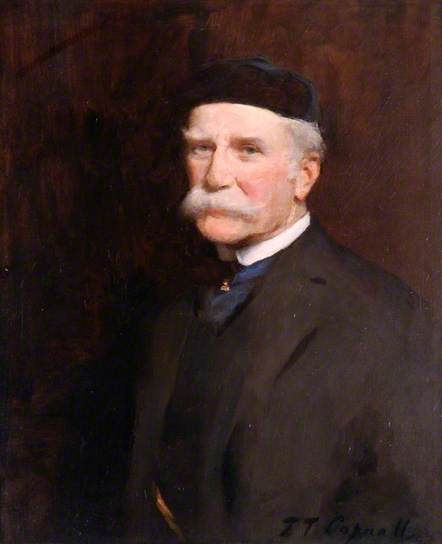
Painting of Douglas Horsfall by Frank Thomas Copnall in Durham University
Howard Douglas Horsfall – Delving into the past
John Woodley
As I sit and admire the brick and stonework of St. Faith's, I marvel at the ingenuity and skill of the craftsmen who created our church over 100 years ago. My thoughts turned to our benefactor, Howard Douglas Horsfall (more often known simply as Douglas Horsfall) and began to wonder how and why he was able to raise a church at this spot. Who was Douglas Horsfall and how did he obtain his wealth to enable him to build St Faith's?
With this as my starting point I conducted research using ‘Ancestry’ (a well-known genealogical website) and was able to find an entry for the Horsfall family in the 1891 census. They were living at ‘Mere Bank’ in Ullet Road, not so very far from the city centre. It was a large household, made up of Douglas’ mother, Emily (listed as the head of the household), his wife (also called Emily) and his children: Winifred, Gladys and Robert. In addition there were eleven servants, made up of lady’s maid, cook, nurse, housemaid, kitchenmaid, butler, footman and groom. Clearly, this was not any ordinary Liverpool family but one perhaps typical of wealthy and prosperous Victorian Britain. Douglas’s occupation is given as a ‘share and stock broker’, a job that would most likely have seen him deal with the buying and selling of shares and advising companies and individuals on investment portfolios.
In 1885, at the age of 26, Horsfall had provided the capital for the building of the beautiful grade I listed St Agnes Church in Ullet Road. Designed by John Loughborough Pearson (who also designed Truro Cathedral), this really is a gem of exquisite craftsmanship and well worth visiting. Shortly after the church was finished, Horsfall had his house, Merebank Hall, built almost opposite the church by the notable architect Richard Norman Shaw. Shaw was also responsible for the design of the vicarage at St. Agnes and the famous White Star building in Liverpool (one of his most notable local buildings). The building of St. Agnes amounted to some £28,000 (about £3 million today).
Clearly, Horsfall was a committed churchman and generous benefactor. Following in his forefathers' footsteps, he maintained a keen interest in the Anglo-Catholic tradition and church building. He had the means and desire to undertake these statements of witness and intent; Horsfall was a serial church builder.
1897 was to be a busy year for Douglas Horsfall. The Liverpool Courier of January 11th reported on the need for an extension to St Agnes as “that church has been inconveniently crowded”. The new church, initially to be a mission church, would nevertheless be well appointed with all the fitments required of a late Victorian church. It was planned to later add a church to the site and for this mission building to become the church hall. I doubt if the larger church building was ever built.
In late May 1897, The Liverpool Daily Post, under a column headed 'The Diamond Jubilee', reported the intended construction of an, as yet unnamed church that, from its description and location, would become St. Faith's. The new church was to be endowed “as a memorial of the Diamond anniversary of the Queen’s reign”. The article goes on to state that Horsfall was a partner in the firm his father started, Horsfall Brothers, stockbrokers of Dale Street.
By comparison to St. Agnes, the cost of building St Faith's in 1898 was a more modest £21,000 (still well over £2 million today). Mark Sargant, who researched the history of the foundation of St. Faith's as part of the centenary celebration of 2000, established that the land upon which the church stands was conveyed to the Church Commissioners by Horsfall’s cousin, Frederick Myers. His cousin had been a landholder in Crosby and at one time owned Crosby House, later sold to the Sisters of Nazareth.
St Paul's Church, Stoneycroft was Horsfall's last church to be built. Designed by Giles Gilbert Scott (of Liverpool Cathedral fame), and with some architectural similarities, this was completed in 1916. Horsfall continued to make his presence felt in later years, making financial contributions to the building of Liverpool Cathedral.
The obituary of Douglas Horsfall, published in the Times in 1936, spoke of his faith and involvement in the Anglo Catholic movement, “Mr. Horsfall was deeply attached to the Anglo-Catholic movement, and so convinced was he of the need for the training of clergy in that school of thought that he founded St Chad's Hall at Durham University in 1904, and at one time was bearing the cost of the training of upwards of 40 men for the ministry.”
On the 8th February 1936, Howard Douglas Horsfall died at Mere Bank, Ullet Road. Despite his generosity over many years in building, supporting, furnishing and providing training for priests, Horsfall was still a wealthy man at his death. He left an estate of nearly £87,000 – the equivalent of over £5 million today.
For anyone interested in finding out more about the Horsfalls, there is a very comprehensive collection of articles and information on the church website which is well worth exploring.
Watch this space for future articles as John delves further...
Back to the Horsfall story index page
Return to Saint Faith`s home page